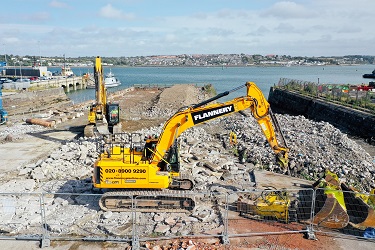 The UK needs energy from the sea to meet ambitious CO2 emissions targets. In what will be Pembroke Port’s historic third reincarnation, work has just begun to make it ready to handle some of the marine giants that will make Net Zero possible.
The UK needs energy from the sea to meet ambitious CO2 emissions targets. In what will be Pembroke Port’s historic third reincarnation, work has just begun to make it ready to handle some of the marine giants that will make Net Zero possible.
Six years ago this October, the Port of Milford Haven threw its support behind a bid for money from UK and Welsh Government’s new City Deal initiative, the aim of which was to fund innovative projects around the country. Across the Swansea Bay City Region different projects resonating with their own areas’ past, present and hoped-for futures were assembled. Pembrokeshire’s contribution was Pembroke Dock Marine, a £60m project that would give new life and purpose to the former Royal Dockyard in Pembroke Dock and kick-start this critical green manufacturing industry.
The Port has been working alongside its partners, Marine Energy Wales, Offshore Renewable Energy Catapult and Celtic Sea Power and all progressing with their respective projects. The project led by the Port of Milford Haven got underway last November with the renovation of the Hangar Annexes at Pembroke Port. These spaces will create offices and workshops for industry and are on track for completion by Spring 2023 (see the Spring 2022 edition of OnBoard for more information). Another major aspect of works broke ground last month. The Port is creating a new extra large slipway, pontoons and dockside roads and spaces ready to handle and service some of the giant marine energy devices already being developed here, that will be deployed off the Pembrokeshire coast.
The contractor BAM Nuttall has been appointed to carry out the work. Andrew Pointon-Ball is the site manager.
“To create the slipway, we will be excavating some 16,000 cubic metres from the dockside and reusing that material to fill in what’s known as the pickling pond, which will create more yard space.”
The rationale is straightforward. The UK expects to derive up to 95% of its energy from low carbon sources by 2030. Bearing in mind gas and coal right now account for 40% of our electricity generation, that is an extraordinary target, only achievable if we move fast to draw energy from natural resources off our coastlines. That means putting big structures in the sea to harness wind, wave and tide. Lots of them.
“We need the space to build, assemble and launch large marine energy equipment in the coming years,” explained Jason Hester, the Port of Milford Haven’s project manager overseeing the work. “Pembroke Port’s location, close to some of the most promising sites for offshore energy, make it the obvious place to centre operations,” said Jason.
Offshore wind will play the greatest role, expected to contribute 50GW of capacity around the UK within 8 years. But technologies including wave energy generation are advancing rapidly. Pembroke Dock-based engineers Bombora are close to completing their first test device, the mWave. This leviathan is Witness No. 1 in the case for upgrading the Port’s infrastructure.
“mWave is 76 metres long and 18 metres wide. It weighs 900 tonnes!” explained Jason. “Moving something like that from Mainstay Marine’s yard to the water requires an enormous amount of space and specialist equipment. We expect to see a lot more devices of this scale, and that is why a slipway the size of a football pitch is required.”
“This is a great project,” said BAM Nuttall’s Andrew Pointon-Ball. “It’s a fantastic location and we are working with a dynamic client. Even to us, it’s obvious how what is happening here is going to benefit local businesses. It’s not without challenges however,” he added. “We’re working in a tidal environment in an active working port right next to a busy ferry terminal. We have to make sure our work doesn’t impact their operations or our other neighbours.”
The work doesn’t stop there. The Port will also be creating new laydown space to the far south of the site. Finally, all the transport links which will allow large equipment to be moved from one side of Pembroke Port to the other will be completed in phase three, as well as looking at better use of the Carriage Drive area. All the work is expected to be completed early in 2025.
“There’s a lot of history under these docks and we don’t want to lose that,” said Jason. “We have undertaken a 3D laser scan of the existing walls along with a photographic and written record. The data will go into an app which means that, by using virtual reality, everyone will be able to see what was here. In addition to this, an archaeologist will be undertaking a watching brief as we excavate the site to ensure that anything we find of historical interest is identified and recorded”.
“In each century of its existence, both Pembroke Port and the town which grew alongside it have repurposed themselves to serve national needs,” said Port of Milford Haven chief executive, Tom Sawyer. “Once completed, Pembroke Dock Marine will play a key role in the UK’s move to Net Zero. We are really looking forward to seeing the opportunities that flow from the marine energy revolution for people living and working around the Waterway.”
Pembroke Dock Marine is funded by the UK Government and Welsh Government through the Swansea Bay City Deal, and through the public and private sectors. It is also part funded by the European Regional Development Fund through the Welsh Government.


